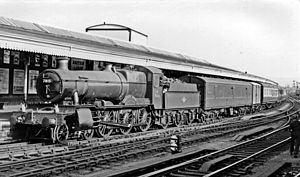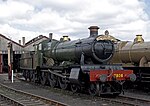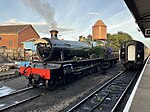| GWR 7800 "Manor" Class | |||||||||||||||||||||||||||||||||||||||||||||||||||||||||||
|---|---|---|---|---|---|---|---|---|---|---|---|---|---|---|---|---|---|---|---|---|---|---|---|---|---|---|---|---|---|---|---|---|---|---|---|---|---|---|---|---|---|---|---|---|---|---|---|---|---|---|---|---|---|---|---|---|---|---|---|
 7815 Fritwell Manor at Gloucester, October 1959. 7815 Fritwell Manor at Gloucester, October 1959. | |||||||||||||||||||||||||||||||||||||||||||||||||||||||||||
| |||||||||||||||||||||||||||||||||||||||||||||||||||||||||||
| |||||||||||||||||||||||||||||||||||||||||||||||||||||||||||
| |||||||||||||||||||||||||||||||||||||||||||||||||||||||||||
| |||||||||||||||||||||||||||||||||||||||||||||||||||||||||||
The Great Western Railway (GWR) 7800 Class or Manor Class is a class of 4-6-0 steam locomotive. They were designed as a lighter version of the Grange Class, giving them a wider Route Availability. Like the 'Granges', the 'Manors' used parts from the GWR 4300 Class Moguls but just on the first batch of twenty. Twenty were built between 1938 and 1939, with British Railways adding a further 10 in 1950. They were named after Manors in the area covered by the Great Western Railway. Nine are preserved.
Background
Although successful mixed-traffic designs, neither the Hall nor the Grange 4-6-0 classes were able to cover the full range of duties previously undertaken by the 4300 Class 2-6-0 locomotives due to their ‘red’ weight classification. By the late 1930s a lighter version of the Grange class was urgently required for those cross-country and branch line duties forbidden to heavier locomotives. A new lighter (Swindon No.14) boiler was therefore designed, and as with the Grange Class, the driving wheels and motion components were recovered from withdrawn members of the 4300 Class. The Manor class, with an axle loading of just over 17 tons, could be utilised on many lines from which the heavier Granges were barred.
Building
The first of the Manors No.7800 Torquay Manor was built at Swindon Works and entered traffic in January 1938. By February 1939 twenty were in service but the outbreak of World War II forced the cancellation of construction of a further batch of twenty locomotives. However, after nationalization, the newly created Western Region of British Railways was authorized to build ten more of the class. Nos. 7820–29 at Swindon in November and December 1950. A batch of ten other locomotives was planned to be released, but the batch was cancelled due to unknown reasons. The cancelled list of Manor locomotives includes the following: 7830 Norton Manor, 7831 Ogwell Manor, 7832 Pimley Manor, 7833 Ramsbury Manor, 7834 Rodley Manor, 7835 Standen Manor, 7836 Sutton Manor, 7837 Thorton Manor, 7838 Widford Manor, and 7839 Wilcote Manor.
Performance
Unlike the Granges of 1936 where the use of a standard design and the re-use of existing components had produced a masterpiece, the initial performance of the Manors was comparatively mediocre, exhibiting poor steaming rates and high fuel consumption. ‘Were it not for the constraints of war there is every reason to expect that Swindon would have recalled the engines for modifications’
It was not until after nationalisation that the Western Region of British Railways sanctioned investigation into the class' shortcomings. In 1951 comparative trials were made between 7818 Granville Manor and a new BR Standard Class 4 4-6-0, which was built at Swindon and fulfilled a similar brief to the Manor class but was designed at the Brighton works under Robert Riddles. This revealed that the front end of the Manor restricted both steam flow and draught on the fire, with the blastpipe being too large in relation to the size of the chimney. The blastpipe's area was reduced by a quarter, while a new design of firebar increased the air space in the grate, allowing more efficient combustion.
These changes doubled the practical steaming rate of the No.14 boiler. A programme of alterations was implemented across the class during 1952, and the Manors started to perform in a similar fashion to the Grange and Hall classes. They were given the same power classification as those types - 5MT.
Operations

The first examples were despatched to depots at Wolverhampton, Bristol, Gloucester, Shrewsbury, Westbury in Wiltshire and Neyland in South Wales. In October 1938 No.7805 Broome Manor underwent clearance tests between Ruabon and Barmouth. Subsequently, the class were used over the main lines of the erstwhile Cambrian Railways, with its headquarters and works in Oswestry. The Manors were also successfully employed in the West Country where they were used for banking and piloting trains over the Devon banks between Newton Abbot and Plymouth. Their light axleloading also allowed them across the Tamar Bridge and on to the branch lines of Cornwall.
By 1959 twenty-one Manors were congregated in Mid- and South Wales. Their most prestigious working was the Cambrian Coast Express, where a Manor took over from a King or Castle at Shrewsbury and worked through to Aberystwyth. Others of the class operated in the Birmingham, Gloucester and Hereford areas while the handful stationed at Reading frequently ventured on to the Southern Region line to Guildford and Redhill.
Withdrawal
The first Manor to be withdrawn was No.7809 Childrey Manor, of Shrewsbury depot in April 1963 and which was cut up at Swindon. By May 1965 the numbers had been halved and the final two in service, No.7808 Cookham Manor of Gloucester, and No.7829 Ramsbury Manor of Didcot, were condemned in December 1965. Remarkably, for a relatively small class where thirty engines were built, nine examples have been preserved. All of which were withdrawn from British Railways service in 1965.
| Year | Quantity in service at start of year |
Number withdrawn | Quantity withdrawn |
Locomotive numbers | Notes |
|---|---|---|---|---|---|
| 1963 | 30 | 1 | 1 | 7809. | |
| 1964 | 29 | 12 | 13 | 7800/05–07/10/15–17/23–25. | |
| 1965 | 17 | 17 | 30 | 7801–04/08/11–14/18–22/26–29. | 7802, 7808, 7812, 7819, 7820, 7821, 7822, 7827 & 7828 Preserved |
Preservation
Operation in preservation
| This section does not cite any sources. Please help improve this section by adding citations to reliable sources. Unsourced material may be challenged and removed. (August 2011) (Learn how and when to remove this message) |
Nine members of the Manor class have survived into preservation with four being GWR built engines and five being BR built examples. One member of the class 7808 Cookham Manor was purchased directly from BR service for preservation by the Great Western Society. The remaining eight engines were all rescued from Barry Scrapyard with the first member of the class 7827 Lydham Manor being rescued in June 1970 and left as the 5th departure from Barry Scrapyard. The last member of the class to be rescued from Barry Scrapyard being 7828 Odney Manor being rescued in June 1981 leaving as the 133rd departure.
All nine members of the Manor class have operated at some point in their preserved career and of the nine Manors to survive in preservation, all four of the GWR built Manors have seen main line operation: Nos. 7802 Bradley Manor, 7808 Cookham Manor, 7812 Erlestoke Manor and 7819 Hinton Manor.
In the 1970s, no. 7808 Cookham Manor was used by the Great Western Society (GWS) to haul nine vintage ex-GWR carriages on an annual outing on the main line from Didcot to Birmingham. Today 7808 is on static display inside the GWS shed at Didcot awaiting an overhaul.
7812 Erlestoke Manor only worked a small number of railtours between April and June 1982. Also certified for main line operation in the 1980s was fellow SVR based engine 7819 Hinton Manor. It worked a number of railtours along former Great Western routes including the Cambrian Coast Line & played a big part in 1985 during the 150th anniversary of the Great Western Railway. 7812 was until New Year's Eve 2017 operational on the SVR but wasn't main line certified and 7819 was until Aug 2018 on static display in Swindon, the engine is now on static display inside The Engine House awaiting an overhaul.
7802 Bradley Manor was the last and most recent member of the class to have operated on the national network, being withdrawn from the mainline in 2007 following the requirement that mainline certified steam engines had to have OTMR fitted by the end of the year. Its last overhaul was completed in November 2015, however it was not certified to operate on the main line.
None of the BR built Manors have operated on the main line in preservation.
Locomotives
See: List of GWR 7800 Class locomotives for all Manor locomotives built. Nine locomotives have been preserved:
| Number | Name | Built | Withdrawn | Base | Current Location | Owner | Status | Livery | Photo | Notes |
|---|---|---|---|---|---|---|---|---|---|---|
| 7802 | Bradley Manor | January 1938 | November 1965 | Severn Valley Railway | Tyseley Locomotive Works | Erlestoke Manor Fund | Under Overhaul, boiler ticket expires: 2032 | BR Lined Green, Late Crest | 
|
Moved to Tyseley in July 2019 following broken piston rod suffered while on loan to the WSR |
| 7808 | Cookham Manor | March 1938 | December 1965 | Didcot Railway Centre | Didcot Railway Centre | Great Western Society | Static Display | GWR Unlined Green, Shirtbutton Logo | 
|
Final member of class to be withdrawn from service by BR |
| 7812 | Erlestoke Manor | January 1939 | November 1965 | Severn Valley Railway | Severn Valley Railway | Erlestoke Manor Fund | Operational, boiler ticket expires: 2032 | BR Lined Green, Late Crest | 
|
Operational on hire to West Somerset Railway in 2023 |
| 7819 | Hinton Manor | February 1939 | November 1965 | Severn Valley Railway | Severn Valley Railway | Severn Valley Railway Charitable Trust | Static Display | GWR Unlined Green, Shirtbutton Logo | 
|
On display in The Engine House awaiting its turn for overhaul |
| 7820 | Dinmore Manor | November 1950 | November 1965 | Gloucestershire Warwickshire Railway | Gloucestershire Warwickshire Railway | Dinmore Manor Locomotive Ltd. | Operational, boiler ticket expires: 2024 | BR Lined Black, Early Emblem
(Red Nameplates) |

|
The engine received an extension to its boiler ticket in September 2023 which will now expire in January 2024. |
| 7821 | Ditcheat Manor | November 1950 | November 1965 | West Somerset Railway | Swindon Designer Outlet | West Somerset Railway Association | Static Display | BR Lined Black, Early Emblem
(Red Nameplates) |

|
|
| 7822 | Foxcote Manor | December 1950 | November 1965 | West Somerset Railway | Tyseley Locomotive Works | Foxcote Manor Society | Under overhaul | BR Unlined Black, Early emblem
(Red Nameplates) |

|
Withdrawn from traffic following failure of copper welds inside firebox. |
| 7827 | Lydham Manor | December 1950 | October 1965 | Dartmouth Steam Railway | Dartmouth Steam Railway | Dart Valley Railway plc | Operational, boiler ticket expires: 2033 | BR Lined Green, Late Crest | 
|
Returned to traffic in October 2023 following completion of overhaul outshopped in BR lined green for the first time in preservation. |
| 7828 | Odney Manor | December 1950 | October 1965 | West Somerset Railway | West Somerset Railway | West Somerset Railway | Operational, boiler ticket expires: 2028 | BR Lined Green, Late Emblem | 
|
Returned to service in December 2018 following repairs |
Model railways
| This section needs additional citations for verification. Please help improve this article by adding citations to reliable sources in this section. Unsourced material may be challenged and removed. (April 2021) (Learn how and when to remove this message) |
Mainline Railways had OO gauge Manor Class models in their catalogue in 1983, with a model of Cookham Manor in GWR green and a retooled model of Lydham Manor in BR lined green. Mainline's tooling was later used by Bachmann Branchline, but is not currently in production. Both Dapol and Accurascale released 00 gauge renditions of the 78xx in Autumn of 2022.
Prior to 2011, Ixion Models created a model of the 78xx in N scale. Dapol purchased the rights to produce the Ixion 78xx in 2011.
See also
References
- Champ, Jim (2018). An Introduction to Great Western Locomotive Development. Barnsley: Pen & Sword Transport. p. 320. ISBN 978-1-4738-7784-9. OCLC 1029234106. OL 26953051M.
- Waters, Laurence (2016). Great Western Manor Class. Pen & Sword Books Ltd. ISBN 978-1-4738-6949-3. OCLC 1296188478.
- le Fleming 1960, p. H36
- ^ Herring 2004, p. 140
- Holcroft 1971, p. 156
- Waters, Laurence. Great Western Manor Class. p. 19.
- Herring 2004, pp. 140–141
- Herring 2004, p. 141
- Jenkins, David (16 January 2024). "New Year 2024 News Update". Erlestoke Manor Fund.
- "GWR 7802 Bradley Manor". Severn Valley Railway. 6 October 2022. Retrieved 19 August 2023.
- "GWR 7812 Erlestoke Manor". Severn Valley Railway. 6 October 2022. Retrieved 19 August 2023.
- "GWR 7819 Hinton Manor". Severn Valley Railway. 6 October 2022. Retrieved 19 August 2023.
- "7820 given boiler ticket extension to January 2024". Steam Railway. No. 551. November 2023. p. 38.
- 7822 withdrawn from traffic following failure of copper welds in firebox Steam Railway issue 548 August 2023 page 38
- The Roster, 7827 returned to traffic in 2023 Steam Railway issue 556 April 2024 page 38
- Duggan, Jamie. "Steam locomotive 7828 Odney Manor returns to traffic and when to see it". Rail Advent.
- "Mainline's big plans for 1983". Rail Enthusiast. EMAP National Publications. March 1983. pp. 36–7. ISSN 0262-561X. OCLC 49957965.
- Bradley, Rodger (1988). GWR Two Cylinder 4–6–0s and 2–6–0s. Newton Abbot, Devon: David and Charles Publishers plc.
- Herring, Peter (2004). Classic British Steam Locomotives. Wigston: Abbeydale Press. ISBN 1-86147-138-6.
- Holcroft, Harold (1971) . An Outline of Great Western Locomotive Practice 1837-1947 (2nd ed.). Shepperton: Ian Allan. ISBN 0-7110-0228-2.
- le Fleming, H.M. (November 1960). White, D.E. (ed.). The Locomotives of the Great Western Railway, part eight: Modern Passenger Classes (2nd ed.). RCTS.
- Whitehurst, Brian (1973). Great Western Engines, Names, Numbers, Types and Classes (1940 to Preservation). Oxford, UK: Oxford Publishing Company. pp. 68–69, 103, 128. ISBN 978-0-9028-8821-0. OCLC 815661.
External links
| Preserved GWR Manor Class locomotives | |
|---|---|
| List of all GWR Manor Class Locomotives |
| Great Western Railway locomotives | |||||||||||||||
|---|---|---|---|---|---|---|---|---|---|---|---|---|---|---|---|
| Swindon broad gauge |
| ||||||||||||||
| Wolverhampton standard gauge |
| ||||||||||||||
| Swindon standard gauge |
| ||||||||||||||
| Absorbed locomotives |
| ||||||||||||||
| Narrow gauge locomotives |
| ||||||||||||||
| By wheel arrangement | |||||||||||||||
| General | |||||||||||||||